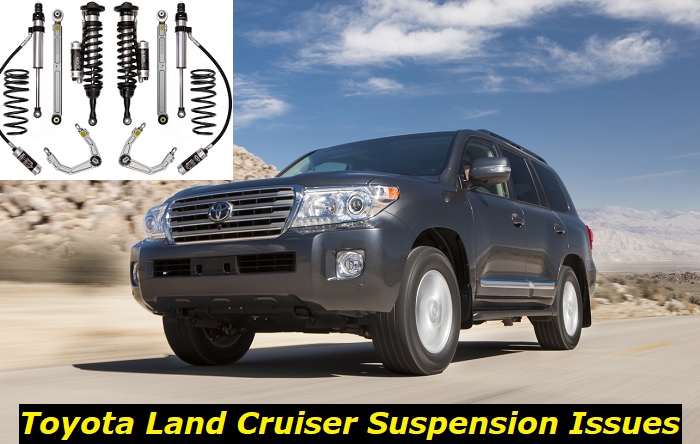The Toyota Land Cruiser is known for its long-lasting performance, quality, and reliability. Apart from its premium SUV status, the said factors are among the key reasons why it enjoys a good resale value in the market. Its high approval scores have also earned it unparalleled customer loyalty over the years, and it continues to attract new buyers up to the present.
Front suspension problems highlights
- Level of importance:high
- Common reasons:road potholes, speed bumps, age, mileage
- DIY inspection:possible but complicated
- DIY repair:usually,impossible
- Average price in shops:$250 - $800
- Average time:2 - 8 hours
- If ignored:fatal failure, no drive, expensive repairs

Common Suspension Issues of the Toyota Land Cruiser
The suspension of the Toyota Land Cruiser is recognized for its intelligent design and durability. In 2008, it adopted the Kinetic Dynamic Suspension System (KDSS), especially for its off-roaders. This was derived from the technology that was first introduced in the Lexus GX back in 2004. On the opposite end of the spectrum, it's also from these complexities where most of its problems tend to nest up.
Based on old and present owners as well as mechanics who had years of experience with Toyota Land Cruisers, here are the common suspension problems that you are most likely to encounter with the vehicle:
1. Air Suspension Bleeding
This problem is common to Toyota Land Cruisers equipped with air suspension. This issue may result in the auto sagging or drooping on one side, which was also dubbed as "KDSS lean" for vehicles equipped with the tech. It can be caused by a leak in the air suspension system. In some cases, you may also hear a hissing sound coming from the affected area.
To diagnose the problem, you will need to check the air lines and connections for any leaks. You may also need to check the air compressor for proper operation. If the compressor is not working properly, it may need to be replaced.
There are several possible solutions to this problem but the most recommended is to replace the air suspension with a new one. An alternative would be to fix the leak and add an air line reinforcement kit, which will help prevent future leaks. Another is to install an aftermarket air suspension kit, which will provide a more reliable air suspension system.
If you notice any of these symptoms, it is important to have your Toyota Land Cruiser checked by a qualified mechanic as soon as possible. Bleeding air suspension can lead to serious problems, including potential safety concerns, if not addressed in a timely manner.
2. Quick Wear of Springs
Worn springs in the Toyota Land Cruiser suspension can cause a number of problems. The most common symptom is a bouncy ride or a tendency for your vehicle to lean on one side even on leveled ground. This can be caused by either the front or rear springs, or both. Other symptoms include poor handling, difficulty steering, and premature tire wear.
There are a few ways to diagnose the cause of these problems. First, check the spring mounts for any signs of wear or damage. If there are any, it's likely that the springs are also damaged and need to be replaced. Next, check the shocks and struts for any leaks or damage.
If they are, they may not be able to properly support the weight of the vehicle, causing the springs to work harder and eventually fail. Finally, take the vehicle for a test drive and pay attention to how it handles and rides. If it feels bouncy or difficult to control, the springs may be to blame.
There are a few possible solutions to worn springs. The most common is to simply replace them with new ones. This is usually the best option, as it will restore the vehicle's ride quality and handling. However, if the springs are only slightly worn, they can sometimes be repaired.
This involves removing any damaged sections and welding in new metal to reinforce them. This isn't always possible though, particularly if the damage is serious, and it's usually best to just replace the springs if they're significantly worn.
3. Inaccurate Tire Pressure Monitoring
One more common problem with the Toyota Land Cruiser is inaccurate tire pressure monitoring. This can be due to a variety of factors, including a faulty sensor, a leak in the system, or simply incorrect tire pressure.
If you suspect that your Land Cruiser's tire pressure monitoring system is inaccurate, there are a few ways to diagnose the problem. First, check the tires themselves to see if they are properly inflated. If not, inflate them to the correct pressure and see if the problem persists.
If the problem does persist, it is likely due to a faulty sensor or a leak in the system. Use a multimeter to determine whether or not a sensor and its wirings are faulty. Next, to test for a leak in the system, pressurize the system and then check for leaks using a soap solution. If there are any leaks, they will be evident by bubbles forming around the point of the leak.
Once you have diagnosed the cause of the problem, there are a few possible solutions. If the problem is due to a faulty sensor and its wirings, they can be replaced with a new one. If the problem is due to a leak, it can be repaired with a sealant specified by your Land Cruiser's manufacturer.
Finally, if the problem is simply due to incorrect tire pressure, be sure to inflate the tires to the correct pressure.
4. Uneven Wheel Alignment
One of the most common suspension problems that can affect the Toyota Land Cruiser is uneven wheel alignment. This can cause many problems, including premature tire wear, decreased fuel efficiency, and poor handling. If left unchecked, it could result in the other problems mentioned in the previous items, too.
If you suspect that your Land Cruiser's wheel alignment is off, there are a few ways to diagnose the problem. Start by checking the orientation of the front wheels. If they are not parallel to each other, then your vehicle likely needs an alignment adjustment.
Another way to tell if your Land Cruiser's wheel alignment is off is by checking the wear pattern on your tires. If one side of the tire is more worn than the other, it indicates that the wheel is not properly aligned.
Going further, you may notice that your vehicle pulls to one side or the other when driving. This is another symptom of an alignment problem.
If you notice any of these signs, it's important to take your Land Cruiser to a mechanic as soon as possible for an inspection. There are a few different ways to fix an alignment problem. The most common solution is to adjust the alignment of the wheels. This can be done by a mechanic through a computer.
In a more serious instance, it may require replacing parts of the suspension system. No matter what the cause of your Land Cruiser's alignment problems is, it's important to have it fixed as soon as possible to avoid further damage to your vehicle.
Ways to Maintain the Quality of the Toyota Land Cruiser's Suspension
A good suspension system is important for any vehicle, but especially so for the Toyota Land Cruiser. This tough SUV was designed to take on any terrain, and a good suspension system is essential for a comfortable ride and safe handling.
Here are some tips on how to properly maintain your Land Cruiser's suspension system:
- Check the shock absorbers and struts regularly. These components take a lot of abuse, especially if you frequently take your Land Cruiser off-road. Make sure they're in good condition and replaced as needed.
- Inspect the suspension bushings regularly. These rubber components can degrade over time, causing noise and vibration. They should be replaced if they show signs of wear or damage.
- Check the ball joints and tie rod ends for wear. These components can loosen over time, affecting your Land Cruiser's handling. Have them replaced as needed.
- Keep an eye on your tires. Uneven tire wear can be a sign of suspension problems. Make sure they're inflated to the correct pressure and rotated regularly.
- Avoid lifting your vehicle's suspension too high. Doing so will put a lot of tension on the suspension of your auto as well as its other components like the hydraulics and electrical systems.
By following these tips, you can keep your Land Cruiser's suspension system in top condition. This will ensure a comfortable ride and safe handling, no matter where you take your SUV.
Conclusion
The Toyota Land Cruiser is considered to be one of the toughest SUVs ever made. That's why its models have aged gracefully over the years. Despite its guaranteed durability though, it is important for you to also do your part in ensuring its quality over time. Therefore, no matter how big or small the problem is, you need to address them right away to prevent them from growing into more complicated issues.
About the authors
The CarAraC research team is composed of seasoned auto mechanics and automotive industry professionals, including individuals with advanced degrees and certifications in their field. Our team members boast prestigious credentials, reflecting their extensive knowledge and skills. These qualifications include: IMI: Institute of the Motor Industry, ASE-Certified Master Automobile Technicians; Coventry University, Graduate of MA in Automotive Journalism; Politecnico di Torino, Italy, MS Automotive Engineering; Ss. Cyril and Methodius University in Skopje, Mechanical University in Skopje; TOC Automotive College; DHA Suffa University, Department of Mechanical Engineering






Add comment